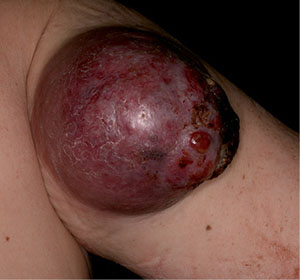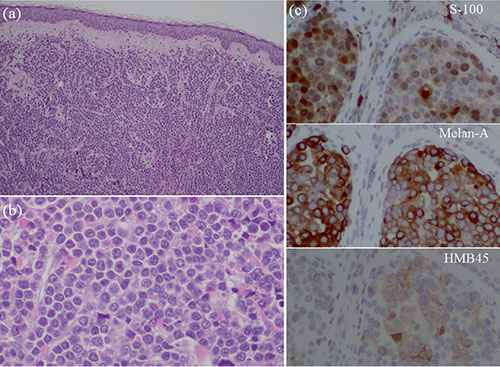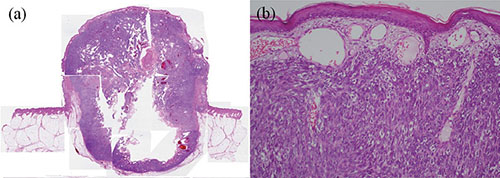Taichi Imamura1, Yasuhiro Nakamura1*, Yukiko Teramoto1, Sayuri Sato1, Yuri Asami1, Eiichi Arai2 and Akifumi Yamamoto1
1Department of Skin Oncology/Dermatology and 2Department of Diagnostic Pathology, Saitama Medical University International Medical Center, 1397-1 Yamane, Hidaka, Saitama 350-1298 Japan *E-mail: ynakamur@saitama-med.ac.jp
Accepted Mar 10, 2016; Epub ahead of print Mar 17, 2016
Primary dermal melanoma (PDM) is a rare variant of melanoma that is confined to the dermis and/or subcutaneous tissue and does not have an epidermal component (1). There are a few published case series of PDM, which suggest that patients with PDM have an excellent 5-year survival rate, ranging from 73% to 100% (1–4). PDM has a more favourable prognosis than that of primary cutaneous melanoma.
More recently, several studies have revealed the molecular features of PDM (4–7). Gene mutation analyses in PDM have not found any mutations in the MAPK pathway genes (4–6). We report here a rare case of BRAF-mutated, giant PDM with rapid progression. This is the first report of PDM harbouring BRAF V600E mutation.
CASE REPORT
A 52-year-old woman presented with a large mass on her right upper arm, which had begun to develop rapidly, one month earlier. Examination revealed a well-demarcated, red-coloured, dome-shaped tumour 8×8×7 cm in size (Fig. 1). The tumour was mobile, with no surface pigmentation. The patient had no history of regression of other pigmented skin lesions. The clinical findings were suggestive of a soft tissue sarcoma.

Histologically, an incisional biopsy specimen showed proliferation of large, round atypical epithelioid cells with prominent vesicular nuclei in the dermis. A narrow grenz zone separated the dermal tumour nests and the overlying epidermis (Fig. 2a, b). There was no evidence of epidermal components or regressive features (Fig. 2a). Immunohistochemical examination demonstrated that these atypical cells were positive for Melan-A, and S-100 protein, and were focally positive for HMB45 (Fig. 2c).
Physical and imaging examinations, including whole-body computed tomography (CT), showed no evidence of primary cutaneous or mucosal melanoma and metastases. On the basis of the histology and immunohistochemistry, and physical and imaging examinations, the lesion was diagnosed as PDM.

Fig. 2. Histological and immunohistochemical analyses of biopsied tumour cells. (a) Atypical cells proliferating in the dermis with no epidermal components (haematoxylin and eosin stain (H&E), original magnification ×100). (b) Tumour cells have polygonal appearance with abundant eosinophilic cytoplasm, prominent vesicular nuclei, and large nucleoli (H&E stain, original magnification ×400). (c) Immunohistochemical staining showing tumour cells positive for S-100 protein (top panel), Melan-A (middle panel), and HMB45 (bottom panel; all original magnification ×400).
Wide local excision, with a lateral margin of 2 cm, and sentinel node biopsy were performed. Preoperative lymphoscintigraphy, single-photon emission computed tomography/computed tomography (SPECT/CT) and real-time indocyanine green fluorescence imaging showed uptake by 2 lymph nodes in the right axilla, which were dissected as sentinel nodes.
Histological examination of the primary tumour revealed well-circumscribed nodular proliferation of tumour nests with hyperplasia of markedly dilated vessels from the upper dermis to the deep subcutaneous tissue (Fig. 3a, b). The tumour nests comprised atypical epithelioid and spindle cells (Fig 3b), which were positive for Melan-A, S-100 protein, and HMB45, and negative for CD21/35, CD23, and CD19. No tumour cells were observed in the epidermis overlying the tumour and there was no evidence of remnant naevus cells in the dermis in any tissue section. The Breslow thickness was 70 mm. One of 2 sentinel nodes showed metastatic involvement. The patient additionally underwent right axial lymphadenectomy, and 2 out of 18 lymph nodes showed metastasis with extracapsular spread. The patient subsequently received adjuvant radiotherapy to the right axilla.

Fig. 3. Histological examination revealing proliferation of tumour nests and hyperplasia of markedly dilated vessels. (a) Haematoxylin and eosin (H&E) staining showing gross pathology with a well-circumscribed dermal to subcutaneous tumour (original magnification ×1). (b) H&E staining shows a lack of tumour cells in the epidermis and dilated vessels in the grenz zone between the epidermis and tumour nests (original magnification ×100).
Three months after surgery, multiple in-transit metastases developed on the patient’s right upper arm. CT revealed numerous metastatic lesions in the lung, liver, kidney and bone, with a maximum diameter of 6 cm. Mutation analysis for BRAF using real-time PCR (Cobas 4800 BRAF V600 Mutation Test, Roche, Basel, Switzerland) detected BRAF V600E mutation in the metastatic lymph nodes. The patient received vemurafenib therapy at a dose of 1,920 mg daily, and she showed a partial response one month after initiation of vemurafenib.
DISCUSSION
PDM accounts for less than 1% of all melanomas (1). In 2004, Swetter et al. (1) proposed the designation PDM to be a subtype of melanoma confined to the dermis and/or subcutaneous tissue that is histologically similar to metastatic melanoma, but is associated with an unexpectedly favourable survival. However, because of its rarity and scant previous studies, it is not known why this subtype was associated with excellent prognosis.
In 2014, Sidiropoulos et al. (7) used a melanoma gene expression-profiling test to demonstrate that, compared with metastatic melanoma, PDM was more commonly associated with a favourable gene expression profile. Apart from the present case report, no reports have shown evidence of BRAF mutations in PDM (4–6).
In contrast, in the present case the primary tumour showed rapid growth, quickly becoming a 70-mm thick tumour with a size of 8 cm, and immediately developing multiple metastases. In the previous case series, the Breslow thickness of PDMs ranged from 3.2 to 27 mm (1, 4, 5, 7, 8). To the best of our knowledge, the present case is the largest and thickest report of PDM, and the first report of PDM harbouring a BRAF mutation. The aggressive behaviour of the tumour may be due to the presence of a BRAF mutation, but the prognostic value of BRAF mutations in melanoma is not clear, as many factors are likely to be involved.
ACKNOWLEDGEMENT
This work was partially supported by the National Cancer Center Research and Development Fund (26-A-4).
REFERENCES
